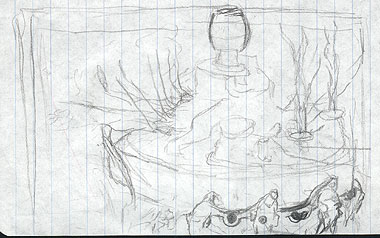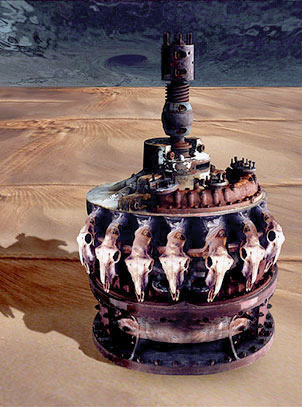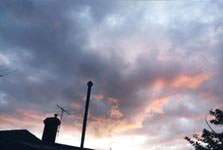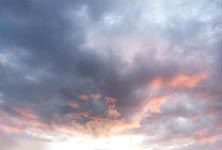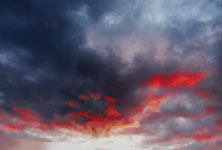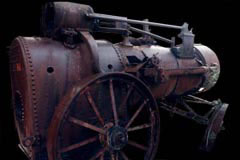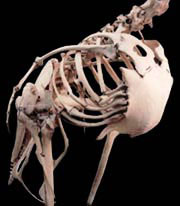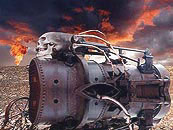 Early in 1997, whilst sitting in at ROAR studios minding a group show I was participating in, I noticed an RMIT short-course magazine lying on the office desk which had on its cover work that could have been done by me but was instead done by a computer artist (Tim Umney). On the back cover was an image that looked like a cross between a painting of mine from 1993 and the work of H.R.Giger, all done on computer. I realised then, that I would have to seriously reconsider my Luddite tendencies, that unless I got my hands on a computer the multitude of ideas that I have for paintings would remain either as rough scribbles on paper or would never be articulated at all. Most of the 2d digital images in the "digital gallery" of this site (5 of the 8) are a selection of works created in an 8 week period from February to April of 1999 after buying a computer and the computer program Photoshop 5 (necroreaper, below, is another). In that short time I created the equivalent in computer images of 3 to 4 years worth of my usual output of paintings. Some of my first digital pieces were based on actual drawings (see below).
To create necroreaper for instance required a considerable degree of patience and time. Merging the various parts seamlessly by getting the texture and colouration right was painstaking. The idea behind my digital images is to create the illusion that the impossible is actual - articulate an idea that is original with its juxtapositions. However, since creating my digital images there has been a proliferation of 'digital artists'. What should be 'digital artisans', or 'digital craftsmen/women', or 'digital illustrators' are referred to as 'artists'. Their work is formulaic. Filters are applied to fudge the edges. 'Noise' in the form of scratches, textures, are overlaid... because somehow, it makes the image more 'painterly', 'art' rather than graphics. In Computer Arts Special magazine, issue 34, 2002, issn 977146511201007 perhaps to ram the point home a plugin "dreamy photo" was included in the cd (included with the magazine) which essentially serves the purpose of turning a photo into 'digital art'. Once there was painting by numbers. Now these formulae are included in computer programs. Instead of being scoffed at users become minor cause celbres. Instead of expressing an idea the work in question is only an exercise in aesthetics, merely illustration/design. Salvador Dali spent a lifetime creating what he termed "hand painted photography" - to create the illusion that the impossible is actual. From Mantegna to Michelangelo to Raphael; from Albrecht Durer to Heironymous Bosch; from David to Dali, art has been about articulating an idea - not fudging it. Wankers producing dross peddle it as art. It's a great leveller. No talent? Grab the computer scan some textures, overlay them onto a collage and .... viola ... digital artist! How skeletised war-machine was created....
My digital images were created using Photoshop 5, on a G3 Power Mac. The photographs which form the basis of these images were taken with my old Pentax Super A SLR camera. The photographs were scanned with an Agfa snapscan 1236. In the past I had amassed a vast collection of photographs taken as back-up for my paintings....you cannot very well drag a portion of rusting engine into your studio! I've taken many more photographs since. The sky in skeletised war-machine was the sky over Melbourne one evening in late January 2000. These are the various images that went into the creation of the image skeletised war-machine. Starting off with the sky photographed from my backyard, I begin by rubber stamping the chimneys & TV antennae out of the picture... then I go into the "selective colour" command to pick out the reds, so that when I insert the flame it will look as though the sky is on fire. The machinery is from the Grampians (Victoria, Australia). A skull is cut, pasted, and then "merged" with the machinery by rubber stamping. The bones that fly away from the skull are the wing bones of an emu... photographed when the Museum of Victoria was still open. The foreground was from a railway line, cut, pasted together and then duplicated with the perspective free transform command applied. The "umbilical cord" is another picture altogether & took as much time to create as the entirety of this image! all images © copyright of Demetrios Vakras
|
|||||||||||||||||||||||||||||||||||||||||||||||||||||||
